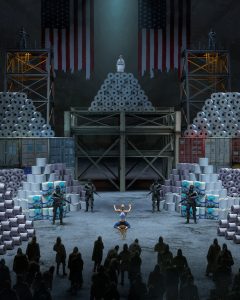By: Vrinda Kapadia, SFU Student
Everydays: the First 5000 Days is a series of drawings and images created by digital artist Mike Winklemann. Professionally known under the name Beeple, he began this project on May 1, 2007 and has been diligently posting a new drawing everyday for 14 and a half years now. Beeple made headlines in March 2021 when he sold an NFT of a digital collage of his project at the staggering price of $69 million.
NFTs stand for non-fungible tokens, which are digital assets representing tangible and intangible commodities. These can include toilet paper, Nike sneakers called cryptokicks, art, virtual avatars, and more. The NFT market is established on a cryptocurrency blockchain, typically the Ethereum blockchain. A blockchain is a shared database that tracks the ownership of the content, while the transactions can be made using cryptocurrency or real money. While, technically, anyone can save, download, and copy the file for free, the real value of an NFT is in the ownership of the original file, which can be purchased and verified by a blockchain entry.
The NFT of Beeple’s art piece was auctioned at Christie’s and was advertised as the “first purely digital work of art ever offered by a major auction house.”
Sifting through his collection, I am very impressed by the consistent quality of Beeple’s artwork. Some images may be dystopic or politically provocative, but overall, his work is very imaginative and captivating. I rummaged through his work from last year to find some satirical renderings of current events.

One is called United States of Toilet Paper from March 14, 2020. Right away, there is an irony portrayed by a confined man on his knees who has soiled his pants when there are mounds of white rolls behind his armed persecutors. The man is appealing to a figure in white attire overlooking him from atop a stacked white paper roll heap. There is a sense of ruthless apathy demonstrated by the armed officials and the man in power while the individual on his knees suffers from a dreadful mishap. This is an unsettling image because it uses the catastrophe of toilet paper scarcity amidst the pandemic to implicitly comment on the alarmingly disproportionate distribution of resources in America.

The second one is called 2020 Easter Bunny from April 12, 2020. This image portrays a shocking twist with its 2020 Easter representation. The subject of this illustration is a humongous, bloody, grubby white bunny reigning over a miniature playground and attacking children. This image seems to be a satirical response to the rollercoaster that the beginning of 2020 was. Beeple seems to forewarn everyone to prepare for their worst nightmares.

There’s also the one called Karen Attack from June 18, 2020. There are military police officers and S.W.A.T team members warding off five gigantic white women. The monstrously big women exude hostility with their audacious posture, dropped jaws, and accusatory finger-pointing. Their glossed-over, fiery yellow eyes indicate no opportunity to reason with them. This rendering is seemingly inspired by the growing popularity of the Karen stereotype, which is typically associated with a self-entitled, middle class white woman who displays aggressive behaviour incited by her privileged status. The exaggeration in the image serves as comic relief within an otherwise strenuous and difficult situation one may find themselves in when interacting with a Karen.
Beeple’s Everydays are introspective and amusing artistic renderings of day-to-day occurrences. Each illustration is a memento of an ideology or a significant event that enters the realm of our collective consciousness as North Americans. Despite their puzzling monetary worth of $69 million today, the project will certainly be more valuable for generations to come as a collection of 21st century relics.






[…] A closer look at digital artist Beeple’s $ 69 million collage The Peak ” “Cryptocurrency” when:1d” – Google News […]